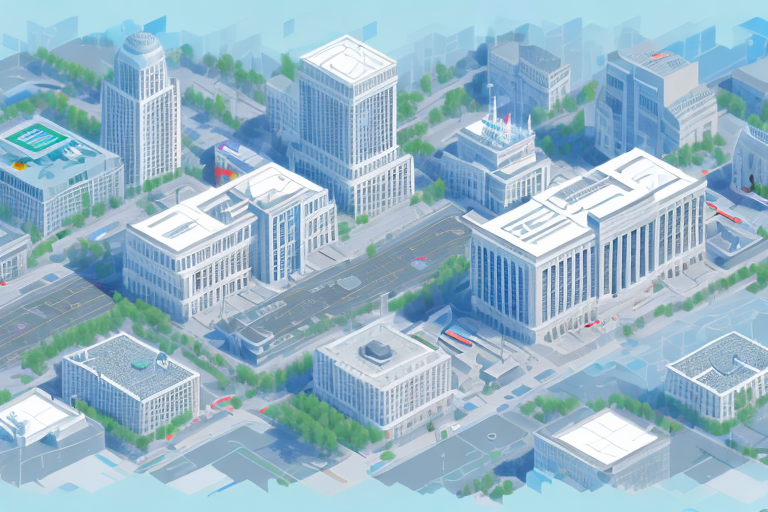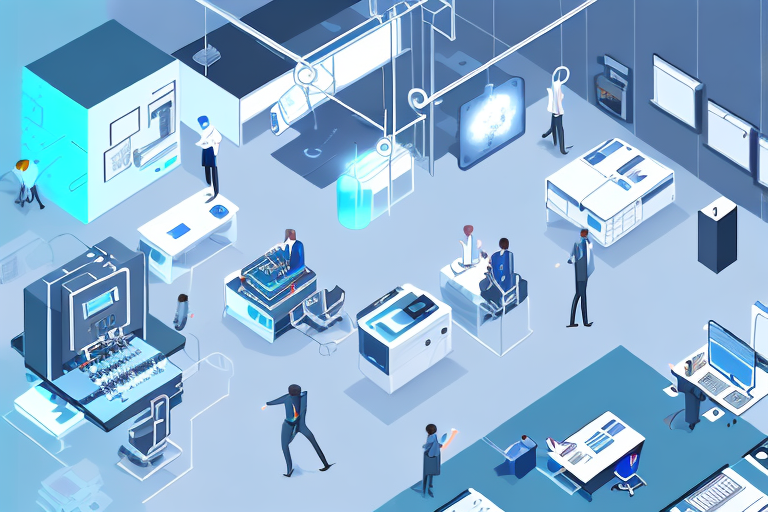Artificial Intelligence (AI) has emerged as a transformative technology in recent years, with the potential to revolutionize various industries. The public sector, often associated with bureaucracy and inefficiency, can greatly benefit from the integration of AI solutions. In this article, we will explore the understanding of AI and its potential, how it intersects with the public sector, its applications in different areas, the challenges in implementing AI, and the future of AI in the public sector.
Understanding Artificial Intelligence and Its Potential
Artificial Intelligence (AI) has become a buzzword in recent years, but what exactly does it mean? AI can be defined as a branch of computer science that focuses on creating intelligent machines capable of simulating human cognitive functions. These functions include learning, reasoning, problem-solving, and decision making. AI encompasses a wide range of technologies such as machine learning, natural language processing, and computer vision.
Machine learning, a subset of AI, involves training algorithms to learn from data and make predictions or decisions without being explicitly programmed. Natural language processing allows computers to understand and interpret human language, enabling them to communicate with us in a more natural and intuitive way. Computer vision, on the other hand, enables machines to analyze and understand visual information, such as images and videos.
The Role of AI in Modernization
The public sector often faces challenges in delivering efficient and effective services due to complex processes, large datasets, and limited resources. This is where AI comes into play. By harnessing the power of AI, the public sector can overcome these challenges and drive modernization.
One of the key benefits of AI in the public sector is the automation of administrative tasks. Mundane and repetitive tasks, such as data entry and document processing, can be automated using AI-powered systems. This not only saves time and reduces human error but also allows employees to focus on more complex and strategic tasks.
Furthermore, AI can greatly improve service delivery in the public sector. For example, AI-powered chatbots can provide instant and personalized assistance to citizens, answering their queries and guiding them through various processes. This not only enhances the overall citizen experience but also reduces the burden on human customer service representatives.
In addition to automation and improved service delivery, AI can also enhance decision-making processes in the public sector. By analyzing large datasets and identifying patterns and trends, AI algorithms can provide valuable insights that can inform policy-making and resource allocation. This data-driven approach ensures that decisions are based on evidence and can lead to more effective and efficient outcomes.
Moreover, the application of AI in the public sector can make organizations more agile and responsive to citizens’ needs. For instance, predictive analytics can help identify potential issues or risks in advance, allowing proactive measures to be taken. This proactive approach can prevent problems before they occur and ensure that services are delivered in a timely and efficient manner.
Overall, AI has the potential to transform the public sector, making it more agile, transparent, and citizen-centric. By automating administrative tasks, improving service delivery, and enhancing decision-making processes, AI can help modernize the public sector and ensure that it meets the evolving needs of citizens in an increasingly digital world.
The Intersection of AI and the Public Sector
The public sector encompasses various government agencies, departments, and institutions responsible for governing and providing services to the citizens. However, many public sector organizations are still reliant on traditional manual processes, resulting in delays, errors, and inefficiencies. The need for modernization has become increasingly urgent.
In order to address these challenges, public sector organizations are turning to artificial intelligence (AI) as a solution. AI presents significant opportunities for the public sector, offering a wide range of benefits and capabilities. By leveraging AI technologies, public sector organizations can analyze vast amounts of data to gain insights, automate routine tasks to free up resources, and enhance citizen engagement through personalized services and chatbot interactions. Furthermore, AI can enable predictive analytics, allowing for proactive decision-making and resource allocation.
One area where AI can have a significant impact is in the analysis of big data. Public sector organizations collect and generate massive amounts of data on a daily basis, ranging from demographic information to financial records. However, manually analyzing this data can be time-consuming and prone to errors. AI algorithms can quickly and accurately process this data, identifying patterns, trends, and correlations that may not be immediately apparent to human analysts. This can help public sector organizations make more informed decisions and develop evidence-based policies.
Another area where AI can be beneficial is in automating routine tasks. Many public sector organizations have a large number of repetitive and mundane tasks that consume a significant amount of time and resources. By automating these tasks using AI technologies, public sector employees can focus on more complex and value-added activities. For example, AI-powered chatbots can handle basic citizen inquiries, freeing up human agents to handle more complex issues. This not only improves efficiency but also enhances citizen satisfaction by providing quick and accurate responses.
Furthermore, AI can enhance citizen engagement by providing personalized services. Public sector organizations can use AI algorithms to analyze individual citizen data and preferences, allowing them to tailor their services and communications accordingly. For example, AI can be used to recommend relevant government programs and services to citizens based on their specific needs and circumstances. This personalized approach can improve citizen satisfaction and increase the effectiveness of public sector initiatives.
Lastly, AI can enable predictive analytics in the public sector. By analyzing historical data and identifying patterns, AI algorithms can make predictions about future events and trends. This can help public sector organizations make proactive decisions and allocate resources more effectively. For example, AI can be used to predict demand for public services, enabling organizations to allocate resources accordingly and avoid bottlenecks. Additionally, AI can help identify potential fraud and abuse by analyzing patterns and anomalies in financial transactions.
In conclusion, the integration of AI in the public sector offers numerous benefits and opportunities. From analyzing big data to automating routine tasks, AI can help public sector organizations become more efficient, effective, and citizen-centric. By embracing AI technologies, the public sector can modernize its operations and deliver better services to the citizens.
AI Applications in the Public Sector
The use of Artificial Intelligence (AI) in the public sector has the potential to revolutionize administrative processes, enhance public services, and improve decision-making. By leveraging AI technologies, government agencies can streamline their operations, provide better services to citizens, and make informed policy decisions.
Streamlining Administrative Tasks
One of the primary challenges faced by the public sector is the burden of administrative tasks. AI can automate repetitive and manual processes, such as data entry, document processing, and record management. This not only saves time and resources but also reduces the risk of human errors. By streamlining administrative tasks, public sector employees can focus on higher-value activities that require human expertise and decision-making.
For example, AI-powered chatbots can handle citizen inquiries and provide information on government services, freeing up human agents to address more complex issues. Additionally, AI algorithms can analyze large volumes of data to identify patterns and trends, enabling government agencies to make data-driven decisions and allocate resources more efficiently.
Enhancing Public Services
AI can significantly enhance public services by leveraging advanced analytics to make data-driven decisions. For example, in healthcare, AI-powered algorithms can analyze patient data to provide personalized treatment recommendations or predict disease outbreaks. This can lead to more effective healthcare interventions and improved patient outcomes.
In the transportation sector, AI can optimize traffic flows and improve public transportation services. By analyzing real-time data from sensors and cameras, AI algorithms can identify traffic congestion patterns and suggest alternative routes. This not only reduces travel time for commuters but also minimizes carbon emissions and enhances overall transportation efficiency.
Improving Decision Making
AI can support decision-making processes in the public sector by providing insights and predictions based on vast amounts of data. For instance, in law enforcement, AI-powered systems can analyze crime patterns to help allocate resources effectively and identify previously undiscovered patterns. This can aid in crime prevention and enhance public safety.
Furthermore, AI can assist in policy formulation and evaluation by analyzing social, economic, and environmental data to assess the potential impact of proposed policies. By simulating different scenarios and predicting outcomes, AI can help policymakers make informed decisions that consider a wide range of factors. This can lead to more effective and evidence-based policies that address societal challenges and promote sustainable development.
In conclusion, the application of AI in the public sector offers immense potential for improving administrative efficiency, enhancing public services, and enabling data-driven decision-making. By embracing AI technologies, governments can better serve their citizens and create more inclusive and sustainable societies.
Challenges and Solutions in Implementing AI
Artificial Intelligence (AI) has become an integral part of many public sector organizations, revolutionizing the way they operate and deliver services. However, the implementation of AI is not without its challenges. In this article, we will explore some of the key challenges faced by public sector organizations when implementing AI and discuss potential solutions.
Addressing Data Privacy Concerns
One of the primary concerns when implementing AI in the public sector is data privacy. With the integration of AI comes the responsibility to protect citizens’ data privacy. Public sector organizations must implement robust data privacy policies, ensuring compliance with relevant regulations.
To mitigate concerns, organizations can adopt privacy-preserving AI techniques, such as federated learning and differential privacy. Federated learning allows data to remain on local devices or servers, reducing the risk of data breaches. Differential privacy, on the other hand, adds noise to the data to protect individual privacy while still allowing for meaningful analysis.
Implementing these techniques can enable public sector organizations to analyze data without compromising individual privacy, building trust among citizens and ensuring the ethical use of AI.
Overcoming Technical Limitations
Public sector organizations may face technical limitations when implementing AI. These limitations can range from a lack of infrastructure to outdated legacy systems that are not compatible with AI technologies.
To overcome these challenges, investment in infrastructure and technology is crucial. Public sector organizations need to allocate resources to upgrade their systems and create a robust AI infrastructure. Collaboration with technology partners and experts can also help identify and implement suitable AI solutions.
Additionally, building internal AI capabilities through upskilling and reskilling is essential. Public sector organizations can provide training programs to employees, empowering them to leverage AI effectively. By investing in their workforce, organizations can ensure a smooth transition to AI-powered systems and maximize the benefits of AI implementation.
Ensuring Ethical Use of AI
As AI technology advances, ethical considerations become paramount. Public sector organizations must establish clear guidelines and principles for the ethical use of AI.
Transparency in decision-making algorithms is crucial to ensure fairness and accountability. Public sector organizations should provide explanations for AI-generated decisions, allowing citizens to understand the reasoning behind them. This transparency can help build trust and mitigate concerns related to bias or discrimination.
Addressing ethical concerns related to AI-powered surveillance systems is also essential. Public sector organizations should ensure that surveillance systems are used for legitimate purposes and are subject to appropriate oversight. Regular audits and external scrutiny can help maintain ethical standards and public trust.
In conclusion, implementing AI in the public sector comes with its own set of challenges. However, by addressing data privacy concerns, overcoming technical limitations, and ensuring ethical use, public sector organizations can harness the power of AI to deliver better services and improve the lives of citizens.
The Future of AI in the Public Sector
Predicted Trends and Developments
The future of AI in the public sector holds immense potential. Emerging trends include the integration of AI with Internet of Things (IoT) devices for smart city initiatives, the use of AI-powered virtual assistants to enhance citizen services, and the adoption of AI in disaster management for real-time decision support. Additionally, advancements in AI technologies, such as explainable AI and AI for social good, will further shape the future of the public sector.
Preparing for an AI-Driven Public Sector
Public sector organizations must prepare for the AI-driven future by embracing digital transformation, fostering a culture of innovation, and establishing frameworks for AI governance. Collaboration between government, industry, and academia is essential to address challenges and drive sustainable AI adoption. By proactively preparing for an AI-driven public sector, organizations can ensure that citizens benefit from the full potential of AI while maintaining accountability and ethical standards.In conclusion, Artificial Intelligence has the potential to modernize the public sector by streamlining administrative tasks, enhancing public services, and improving decision-making processes. However, the implementation of AI in the public sector is not without challenges. Addressing data privacy concerns, overcoming technical limitations, and ensuring ethical use of AI are critical to successful adoption. Looking ahead, the future of AI in the public sector holds promise, with emerging trends and developments reshaping the way governments serve their citizens. It is imperative for public sector organizations to proactively prepare for an AI-driven future to unlock the full potential of this transformative technology.
In conclusion, Artificial Intelligence has the potential to modernize the public sector by streamlining administrative tasks, enhancing public services, and improving decision-making processes. However, the implementation of AI in the public sector is not without challenges. Addressing data privacy concerns, overcoming technical limitations, and ensuring ethical use of AI are critical to successful adoption. Looking ahead, the future of AI in the public sector holds promise, with emerging trends and developments reshaping the way governments serve their citizens. It is imperative for public sector organizations to proactively prepare for an AI-driven future to unlock the full potential of this transformative technology.




